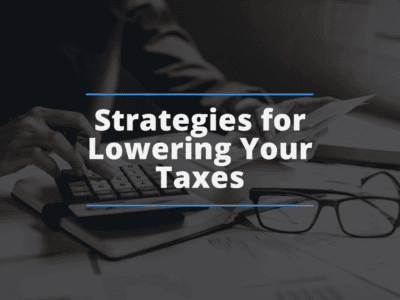Picture this: You’ve worked hard all your life, diligently saving for retirement. Now that the time has finally come to enjoy your golden years, you’re unpleasantly surprised by a big tax bill. Retirement income may be lower than your working years, but that doesn’t mean your taxes will magically vanish.
The good news is that tax planning in retirement doesn’t need to be stressful. With the right strategies, you can significantly lower your tax burden and keep more of your hard-earned money. In this guide, we’ll explore the ins and outs of taxes in retirement and provide you with practical tips on how to minimize your tax bill. Specifically, this article is designed for people nearing retirement or already in their retirement years.
Understanding Retirement Income and Taxes
Before we dive into strategies, it’s important to grasp the different types of retirement income and how they’re taxed. Here’s a breakdown of the most common sources:
- Traditional IRAs and 401(k)s: Contributions to these accounts were likely made with pre-tax dollars, meaning you received a tax deduction at the time you contributed. However, withdrawals in retirement are taxed as ordinary income.
- Roth IRAs and Roth 401(k)s: These accounts are funded with after-tax dollars, so you don’t get a deduction upfront. The upside? Qualified withdrawals in retirement are tax-free!
- Social Security Benefits: Depending on your total income, some portion of your Social Security benefits may be subject to federal income tax.
- Pensions: Most pensions are considered taxable income, so they’ll contribute to your overall tax burden.
Additionally, be aware of Required Minimum Distributions (RMDs). Once you reach a certain age, typically 72, you’ll be required to take annual withdrawals from your traditional retirement accounts. RMDs are taxable, so they’ll need to be factored into your retirement tax strategy.
Tax-Minimizing Strategies
Now that you understand the tax rules around retirement income, let’s explore how to use that knowledge to your advantage:
Maximize Contributions to Tax-Advantaged Accounts
Even if you’re approaching retirement, it’s not too late to benefit from traditional IRAs and 401(k)s. Contributions typically reduce your taxable income in the year you make them. This means you’re paying less tax now while building your nest egg for the future. There may also be catch-up contributions for those eligible after 50, let’s you put away even more.
Consider Roth Conversions
Moving money from traditional IRAs or 401(k)s to Roth accounts involves paying taxes on the converted amount. However, it can be strategic in the long run if you believe your tax rates will be higher in retirement. This allows you to have a pool of tax-free income in the future, potentially reducing the overall tax burden.
Strategic Withdrawals
Your income from various retirement accounts can fluctuate from year to year, potentially pushing you into higher tax brackets. Plan your withdrawals strategically to minimize the overall tax impact. For example, it might sometimes make sense to take extra withdrawals from a traditional account in a year when your income is lower and your tax rate is less.
Invest in Tax-Efficient Assets
Bonds, particularly municipal bonds, offer potential tax advantages. Interest earned from municipal bonds is often exempt from federal income tax, and sometimes state and local taxes as well (depending on where you live and where the bond is issued). This can be a smart way to diversify your portfolio and generate income that isn’t heavily taxed.
Important Note: Always consult with a financial advisor to discuss tax implications associated with Roth conversions and account withdrawal strategies. These are important decisions that require personalized advice.
Additional Considerations
- Tax Brackets: The U.S. has a progressive tax system, meaning you pay a higher percentage in taxes as your income increases. Understanding how tax brackets work will help you plan your withdrawals and stay within lower brackets whenever possible. You can find the latest federal tax brackets on the IRS website https://www.irs.gov/.
- Healthcare Costs: Unfortunately, healthcare costs tend to increase as we age. Some of these expenses may be tax-deductible if they exceed a certain percentage of your adjusted gross income. If you anticipate high out-of-pocket healthcare expenses, that may factor into your retirement tax planning.
- Consult a Tax Advisor: Navigating tax laws in retirement can get complicated. A qualified tax advisor can offer personalized guidance based on your specific financial situation and goals. Think of this as an investment towards maximizing your retirement funds.
Conclusion
Retirement doesn’t have to come with a side of hefty tax bills. By understanding the tax implications of your retirement income and implementing strategic planning, you can make significant strides in lowering your taxes. Remember, tax planning is an ongoing process, so continually revisit your strategies and consider consulting with a professional for the most tailored guidance as your situation evolves.
Ready to take control of your retirement taxes? Here are some actionable next steps:
- Research: Continue learning more about tax strategies. There are many resources online and in libraries about maximizing retirement income.
- Speak with an Advisor: Schedule a consultation with a tax advisor or a financial planner specializing in retirement planning.
- Start Planning! Even small actions now can have a big impact later. Start putting some of the strategies we discussed into practice.
